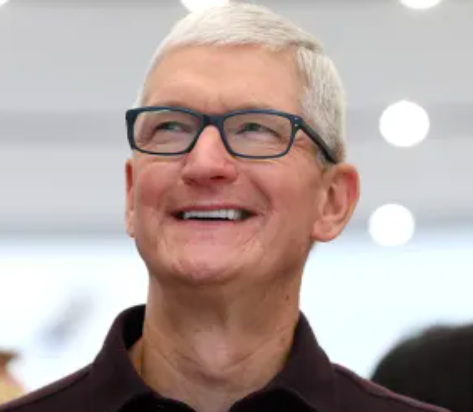Is Tim Cook out of Fresh Ideas? Different sized Ipads and Iphones does not Equal innovation.

Tim Cook was never a product genius. But right now, that’s exactly what Apple needs.
When Steve Jobs returned to Apple in 1997 after a 12-year hiatus, the company was in free fall. It was on the verge of bankruptcy after cycling through a series of chief executives, faced immense competition in the personal-computer market, and desperately needed to find its next big thing. Jobs immediately cut bait on a series of dead-end projects to refocus the company.
The following year, his strategy bore fruit. Jobs unveiled the iMac, and its vibrant plastic shell instantly flew off the shelves and into the annals of iconic design. Then came the iPod in 2001, upending the personal-media-player space and popularizing iTunes. That set the stage for the iPhone in 2007, which shot Apple into the stratosphere and fueled a slew of side businesses, including the App Store, that generated many billions of dollars. By the time Jobs died in 2011, Apple was the most valuable tech company in the world.
Then Tim Cook took over.
Cook is a numbers guy, not a design guy. Under his tenure, Apple’s share price has soared, and investors have been kept happy with increased share buybacks and a quarterly dividend. But other than the Apple Watch, which was already in the works before Jobs’ death, there have been no earth-shattering product launches. Instead, his time as CEO has been defined by squeezing as much as possible out of the successes of the second Jobs era. But after a decade of doing that, iPhone sales are slowing, revenue is down, and the company, again, needs to find its next big thing.
The tech industry is littered with once dominant firms such as IBM and AT&T that lost their innovative edge once they’d grown to a particular size and were usurped by savvy upstarts. Those companies haven’t disappeared, but they don’t command the power or public image they once did. Silicon Valley’s giants, including Google and Meta, are now facing a similar challenge — and Apple is no exception. Cook’s strategy of focusing on short-term profit over long-term strategy is casting a shadow over Apple’s future.
The iPhone is Apple’s cash cow — sales of the smartphone are responsible for more than half the company’s revenue. But in 2017, after Apple took over the US market and there were no more Americans to sell iPhones to, sales hit a wall. The phones were good enough that people didn’t need to regularly upgrade, and growth in developing markets wasn’t delivering as well as the company had expected. The following year, Apple stopped reporting how many phones it sold, focusing instead on revenue: If the company couldn’t get more people to buy iPhones, it would start charging more for phones and iPads via premium tiers. That worked for a few years, but in 2022, sales slowed again, and Apple’s other products took a hit, too.
In 2023, the company saw four quarters of declining revenue, which rebounded in its fiscal first quarter of this year after strong holiday demand, only to decline again in the second quarter. Apple’s own outlook suggests poor iPhone sales will persist, especially as sales in China rapidly decline.
While growth in other parts of the Apple universe — TV+, News+, and iCloud storage, to name a few — was a highlight on the recent earnings report, their continued success is dependent on Apple hardware. To make matters worse, this tidy ecosystem is coming under threat from the US and other governments.
The drawbacks of Cook’s divestment from product design and development are now becoming clearer.
As the Justice Department’s recent antitrust case against Apple makes clear, the company’s success stems in part from its walled garden that makes it difficult for users to switch to Android devices. By ditching their iPhones, users lose their App Store purchases and access to proprietary features such as iMessage. The antitrust case seeks to lower the barrier to switching and remove some of the exclusive benefits of using Apple devices. One focus is on reducing the restrictions on “superapps” such as WeChat that offer many services within the same app regardless of the operating system. If users rely on superapps instead of those included with the device, it’s easier for them to move between iOS and Android whenever they want.
In Europe, lawmakers are focused on breaking the monopoly of the App Store by trying to ensure third-party apps and stores can be loaded onto Apple devices. If that happens, it would be devastating for the revenue Apple receives from App Store purchases — up to 30% of each purchase. Both the EU and the US cases would also make some people more likely to switch to a cheaper phone, which would threaten iPhone sales even further. In response, the company plans to vigorously fight the US case and is trying to shape how EU rules apply to its business to weaken their effectiveness.
Back at Apple’s showrooms, however, its problems have multiplied.
In his book “After Steve,” Tripp Mickle describes how Cook was focused on growing Apple’s share price and operational efficiency — with him saving the company money at every turn. He had a firm command of Apple’s supply chain and was instrumental in setting up Apple’s tax-avoidance mechanisms. After taking over the company, Cook slowly reined in the powerful design team, eventually leading Jobs’ ally Jony Ive, the chief design officer, to leave the company in 2019 after years of reducing his time there. The drawbacks of Cook’s divestment from product design and development are now becoming clearer.
Already this year, we’ve seen two major flops from Apple. The first is the Vision Pro headset, a cumbersome and obscenely expensive piece of hardware that users are supposed to wear on their heads for extended periods of time (never mind the potential for nausea or eye strain). Given that virtual-reality headsets have been pegged as the future many times in recent decades before fading back into obscurity, it’s hard to believe Apple’s current effort will be any different.
At its core, Apple is a hardware company, and Cook has not been able to shepherd another product of market-shattering scale to shelves.
The company’s initial goal wasn’t to build a headset but to put a computer in a regular pair of glasses. Even though the technical limitations to achieving that vision quickly became clear, people who worked on the project told Bloomberg that internal divisions and indecisiveness by management kept the project in limbo for years, even as the annual burn rate reached $1 billion. Once Cook decided Apple had to release something, it ended up with the Vision Pro — a far cry from the sleek, lightweight glasses he initially dreamed of. Already, surveys have found the devices are being left unused, and flagging demand has caused the company to cut back on production.
Meanwhile, the Apple Car didn’t even make it out of the gate. It was born out of the self-driving-vehicle hype of the mid-2010s, and Apple poured $10 billion into its development. But after almost a decade of work, it finally canceled the project in February once it realized the autonomous-driving technology it had been working on simply wouldn’t be able to pilot a vehicle without human intervention. The century-old car business, it turned out, was much trickier to navigate than it may have first appeared.
Let’s be clear: Apple is far from irrelevant. It still occasionally claims the title of most valuable publicly traded company in the world and even eclipsed a market capitalization of $3 trillion for a time last year. Investors aren’t too despondent because Apple has increased its profit margin even as it struggles to grow its revenues. But looking further down the road, its future is far from certain.
Apple’s share price is down this year, and it’s lagging behind the Nasdaq-100 index. Cook was recently jetting around Asia to try to shore up the supply chain with expanded production in India and a new footprint in Indonesia, but it’s hard to see those countries becoming major markets for the iPhone. Like in China, most of those consumers are more likely to go for an affordable Android phone with features that are just as good — the iPhone just isn’t the status symbol it once was.
Apple is now pivoting, like everyone else, to generative AI. It moved employees from the car project over to artificial intelligence and plans to incorporate AI into releases of its iPhone, iPad, and Mac software. But while AI might drive short-term investor interest, like so many fads in the tech industry — crypto, the metaverse, the mid-2010s AI hype cycle — it’s unlikely to be the kind of product that makes a big difference to the bottom line, especially with growing concerns about the cost of generative-AI tools. Plus, what we call AI is not actually a new tool; there’s already plenty of AI deployed through Apple’s operating systems to check users’ spelling or improve their photos.
Peter Kafka explained in March, “For years, it has been clear that there is no next iPhone.” Now that Apple has failed to deliver a big step forward with the Vision Pro or Apple Car, its retreat into AI suggests it’s chasing trends to keep up interest as it struggles to chart a defining next step.
Apple has had a great run over the past decade, and Cook has returned a lot of value to shareholders by persuading consumers to pay more for the company’s devices. But at its core, Apple is a hardware company, and Cook has not been able to shepherd another product of market-shattering scale to shelves. It’s not clear he ever will.






